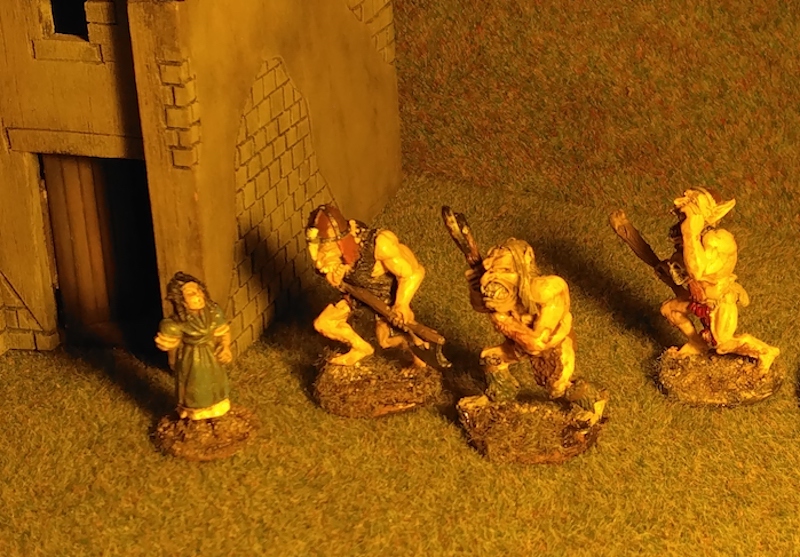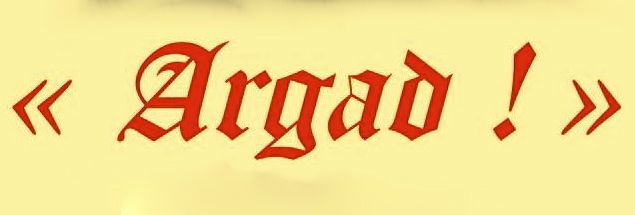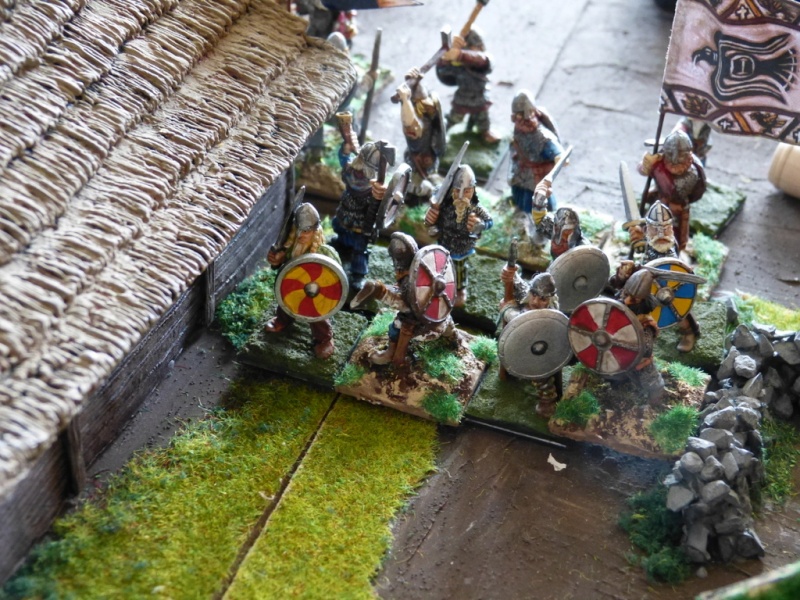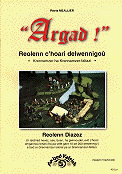|
A mix of RPG and miniature skirmish The rules are devised for 28mm miniatures and work better when a game master (GM) or organiser imagines a scenario and story. They may also be used for 1/72 or 20mm figures. Our "friendly simultaneous" (no IGOUGO, no initiative) system may seem strange and unfamiliar at first but is simple and encourages very fast moves and daring actions. Everyone may move simultaneously as in true life, you don't have to just sit and wait while enemy troops are moving. Quick reference sheets include movement, shooting, and melee tables, which can be used easily to play adventures, skirmishes and fights. Each player is represented by a character: adventurer, warband chief, military officer... accompanied by a small bunch of followers or small troop of warriors... or pirates... or soldiers... (typically 10-30 strong) or by only a handful of companions. Players are encouraged to imagine that everyone running on the gaming table is really alive (not game pawns) and do not have to face boardgame-minded tactical choices that their characters could not understand. The most efficient tactic, as in true life, is to outnumber the enemy where it's really important; once in contact the dice do the rest ...but the best games happen when players try to delay or to avoid battle as long as possible. The system is so fast-flowing that 5-6 players can do 30-40 game turns and often more in a few hours, this allows many moves, terrain exploration, diplomacy... The rules may also be used for scenarios where players should collaborate instead of fighting each other (as in more traditional RPGs) in which case their opponents are non-player characters (NPCs) handled by the GM / referee. Such games are often easier to prepare and to run, especially with new players or at a convention. More extensions and explanations are always under work and/or being tested. We apologise for awkward syntax and wording in the translations in English. "Argad" means "attack" in the Breton language (from the word "kad" which means fight or battle, same origin as the words "cad" in Welsh and "cath" in Irish). Click on the PDF symbols to see or download the documents |
|
Updated generic rules. This PDF document (48 pages) explains the whole basic system, states clearly what these rules are about and what they are not (this proved necessary to avoid confusion or disappointment), answers a number of issues which had raised questions, and a large part is devoted to suggestions and ideas for the RPG dimension which is the main interest and purpose of the rules. — Argad! generic rules 48 pages, updated October 2023 — Argad! generic supplement for cavalry and mounted troops (18 pages, updated May 2022) is here. — Argad Lite the very basic and simple system on which the whole ruleset has been built. One page to play medieval games, one page to play pirate games (2 pages, updated June 2023) here. |
|
Dark Ages & Middle Ages
Weapons are mentioned when useful in a precise context, or omitted when unnecessary, but all reference sheets are compatible.  (A
5-pages compilation of shooting tables
and optional rules for bows and
crossbows which appear separately in
other documents; including optional
rules and the beginning of a fantasy
extension.)
|
Sengoku Japan
Reference
cards (3 pages), easier to
read during the game, have
been added to the (2 pages)
reference sheet.
The
Argad Sengoku extension (9
pages) now is a separate
document.
Two short videos made by a young
player some years ago,
the other players and the GM did
not even notice he was filming!
|
Black
powder & muskets
Weapons are mentioned when useful in a precise context, or omitted when unnecessary, but all reference sheets are compatible. Mid-16th
century to mid-17th century, new
16-pages extension
 NEW: April 2025
NEW: April 2025(including updated reference sheet)  Reference
sheet, privateers and pirates c.1700
(ashore)
 updated January 2024
updated January 2024
The privateers and
pirates reference sheet may also
be used with the previous sheet
for early buccaneers, or with the
following one if other details are needed. No naval rules are
included, the game system may be used in
conjunction with those you like best; or
ships may be at anchor or grounded when a
game begins.
Remark: the usual melee system did not work well for cavalry lancers of this period. The next updates will include the following rule: 19th century cavalry has +1 modifier when charging in melee (as usual) ...except in the following cases (where the charge has less impact): - if charging against infantry waiting immobile in close order (and not in disorder), or - if lancers charging against enemy cavalry that charges them. Also, 19th C. cavalry lances lose their length advantage after the first game turn of a melee, they will regain it after one game turn of clear separation from the melee. Tables for 18th C. and early 19th C. firearms  January 2021
January 2021 These two last
documents are valid from c.1700 till the
first decades of the 19th century (and
even till Zorro, The Miserables, and the
Alamo).
Characters
sheet for two
duelling hussars (one
page, May 2023)
...And a
video of an Old West game, played with an
adaptation of the rules ...that is not yet
online as it still needs better explanations
and new updates:
|
Fantasy
A medieval-fantasy dimension is included in the rules since the first edition (1996) with different categories of humanoids depending on their strength compared to Humans (written -H, =H, +H, ++H...) +1, +2, –1 or -2 modifiers etc. were added to, or deduced from, a D6 when fighting weaker or stronger creatures. It worked quite well but was sometimes clumsy with too many modifiers on top of usual tactical factors, and it prevented from devising more variety (which would have meant more modifiers) between humanoid species. The former strength categories are maintained but with a new, more effective, system using D4, D8, D10, D12 (not for humans who always use a D6 in historical and fantasy contexts). Generic humanoid system (June 2023)  here.
here.An off-table generic explanation that gives an overall view of the fantasy system and will help to devise more detailed creatures and monsters. It will be completed by more precise reference documents for many species. Erratum: the die for wounds of strong creatures (D2, D3 or D4) should be rolled at the end of the game phase not of the game turn; this will be corrected in a next update. Document and reference cards for Ogres and Half-Ogres (updated March 2024)  here.
here. No real change but some more explanations and details, AND more practical reference cards for easy use in the game. The document and reference cards for giants and giantesses are temporarily withdrawn for updates (correction of the rock throwing chart, addition of reference cards, addition of a page about Cyclopes).  Why Ogres and giants? because these creatures are quite close to humans (as friends or as foes) and may appear as well in half-historical legendary countries than in purely fantastic worlds; because of this they have been helpful to test and improve the new system. ;) Document and reference cards for Orcqs (5 pages, updated September 2025)  here.
Orcqs with bows or Xbows shoot very badly...
here.
Orcqs with bows or Xbows shoot very badly...The rules are not linked to any peculiar universe or fantasy world. The GMs or game organisers may devise what they wish and adapt or change the suggested humanoid categories and descriptions as they need. |
Currently under work: — More detailed extensions for the Dark Ages, the FIW, and Napoleonics, are being studied. |
Older suggestions and ideas (parts of which may be outdated) PCs, NPCs, wounds and healing (December 2013) Meteo dice & emoticon dice (March 2012) |
Some inspiring AARs, with many pictures!
— 28 mm - 25 mm:
Dark Ages (Arthurian)
Family
secrets (in French)
Struggle for Kerantrech: here
and here
A village between them
The giant in the valley
Revenge for a village
A village too far
Dark Ages (Vikings)
My drakkar for a horse!
The infamy of Leif Sigursen
Early Hundred Years War (War of the Breton Succession, mid-14th century)
The joust at Ploërmel (in French)
An Davarn Ruz (The Red Inn)
A village between them
The giant in the valley
Revenge for a village
A village too far
Dark Ages (Vikings)
My drakkar for a horse!
The infamy of Leif Sigursen
Early Hundred Years War (War of the Breton Succession, mid-14th century)
The joust at Ploërmel (in French)
An Davarn Ruz (The Red Inn)
Big
rise in traitor value (in French, many detailed
pictures)
Smoked sausages and sour betrayals
Two dukes, one crown
A fight for a dyke
The banks of the river Loire
Return of the alchemist
A village of merchants
Black powder and alchemist blood
Samurais (Sengoku Japan)
Smoked sausages and sour betrayals
Two dukes, one crown
A fight for a dyke
The banks of the river Loire
Return of the alchemist
A village of merchants
Black powder and alchemist blood
Samurais (Sengoku Japan)
The
battle of Nagashino (in French, many detailed
pictures)
Attack on Nagashino castle (in French, many detailed pictures)
Attack on Nagashino castle (in French, many detailed pictures)
A
bitter victory (in French, many detailed pictures)
Hunting and other things (in French, many detailed pictures)
Hunting and other things (in French, many detailed pictures)
Yoshimoto's
wedding (in French, many detailed pictures)
Fall of the Haru clan (in French, many detailed pictures)
Eliminate all threats on your domain (in French, many detailed pictures)
Fall of the Haru clan (in French, many detailed pictures)
Eliminate all threats on your domain (in French, many detailed pictures)
Defend
the borders (in French, many detailed pictures)
Hojo unification (in French, many detailed pictures)
Ichi's revenge (in French, many detailed pictures)
Bad karma for the heirs (in French, many detailed pictures)
Hard Times for Nakagawa Family (in French, many detailed pictures)
The Fate of a Merchant (short video and AAR in French)
First game in a 16th century (Sengoku period) campaign
Border reivers, Late 16th century
Border troubles - Trioblaidean criche
Wars of Religion in Brittany, Late 16th century
Hojo unification (in French, many detailed pictures)
Ichi's revenge (in French, many detailed pictures)
Bad karma for the heirs (in French, many detailed pictures)
Hard Times for Nakagawa Family (in French, many detailed pictures)
The Fate of a Merchant (short video and AAR in French)
First game in a 16th century (Sengoku period) campaign
Border reivers, Late 16th century
Border troubles - Trioblaidean criche
Wars of Religion in Brittany, Late 16th century
Thirty Years War
Beer, wagons, and spells
Pictures of another TYW game
Pictures of a TYW skirmish game
Another TYW skirmish...
A TYW skirmish...
Privateers and pirates c.1700
A game for two pirates
Mystery at Saint-Domingue
Raid on San Augustin
Tobacco smuggling on the coast of Brittany
WoSS and pirates game on three tables
French & Indian War (SYW in North America)
Scalps, fights, and hard liquor (in French, many detailed pictures)
Beer, wagons, and spells
Pictures of another TYW game
Pictures of a TYW skirmish game
Another TYW skirmish...
A TYW skirmish...
Privateers and pirates c.1700
A game for two pirates
Mystery at Saint-Domingue
Raid on San Augustin
Tobacco smuggling on the coast of Brittany
WoSS and pirates game on three tables
French & Indian War (SYW in North America)
Scalps, fights, and hard liquor (in French, many detailed pictures)
Napoleonic
Cold weather at Isbaskaya (retreat from Russia)
Hot paella (Peninsular 1813)
Strange skirmishes in Louisiana 1812-15
An obviously non-Waterloo first game just to test the rules extension (in French)
La
vallée vierge (in French)
The eye of the Sad Dragon
A pyramid with hyenas
The temple of the Sad Dragon
The eye of the Sad Dragon
A pyramid with hyenas
The temple of the Sad Dragon
—
1/72 plastic - 20mm (in French):






